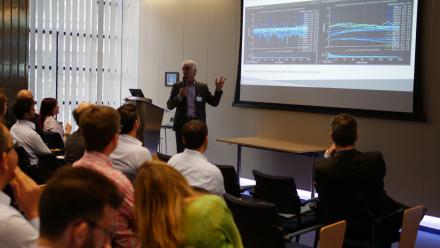The European GNSS Agency (GSA) hosted the GNSS Raw Measurements Taskforce workshop “GNSS Raw Measurements: From research to commercial use” on May 30, to share and explore experiences, use cases and opportunities enabled by Android GNSS Raw measurements.
The workshop was attended by over 80 participants from industry and from the academic and research communities and included over 20 presentations and two demonstrations by GEO++ and Spirent. The participants shared their experience with Android raw measurements in three exciting domains: high accuracy applications; scientific, educational and robustness applications; and applications for testing and optimisation.
from the academic and research communities and included over 20 presentations and two demonstrations by GEO++ and Spirent. The participants shared their experience with Android raw measurements in three exciting domains: high accuracy applications; scientific, educational and robustness applications; and applications for testing and optimisation.
Promising results arising from the use of raw measurements were presented, both involving the use of raw data for high accuracy techniques and for testing a constellation or combination of constellations. The workshop also took a look into the future, in a session on the outlook for geolocation in the mass market, where participants discussed the increased accuracy, availability and robustness that Galileo will contribute.
Frank van Diggelen, principal software engineer at Google provided a keynote presentation on Android GNSS measurements along with a vision for advanced location services. He spoke in particular about the new Android features to be enabled with new APIs (application programming interfaces) and enhancements of GNSSLogger, Google`s raw measurements analysis tool.
Dual frequency opportunities
Broadcom’s Miguel Torroja stressed how dual frequency will change performance levels in the mass market. “Until today, mass market devices have been single frequency only, but the industry is now moving towards dual frequency, with a resulting increase in accuracy in open environments and more robustness to multipath in urban scenarios,” he said.
Read this: World’s first dual-frequency GNSS smartphone hits the market
Highlighting the role of Galileo within the use of GNSS raw measurements, Airbus’ Moises Navarro Gallardo, said that by including Galileo in the position, velocity and time (PVT) solution through the use of raw measurements, users will easily experience the added accuracy and availability that Galileo provides.
New horizons with Galileo
GSA’s Fiammetta Diani provided a status update on Galileo along with an overview of new services to expect in the near future – specifically high accuracy and authentication.
“Open signal navigation message authentication will help mitigate the vulnerabilities of GNSS and is a clear differentiator of Galileo with respect to other GNSS available to the public,” she said. As regards high accuracy, she said that this would be based on Precise Point Positioning via Galileo E6 without the need for an additional communication channel. This will be gradually implemented between 2018 and 2020.
In particular, three key additions to the integrity navigation (I/NAV) message for OS users on E1B will further increase compliance with the relevant 3GPP standard.
According to GSA’s Flavio Sbardellati: “Reduced clock and ephemeris data (redCED) will enable the computation of coarse position in a faster time to first fix, while secondary synchronisation pattern (SSP) will strengthen synchronisation with mobile networks.” Sbardellati added that additional forward error correction (FEC2) would improve data tracking in difficult environments.
The presentations from the workshop can be downloaded here.
About the GNSS Raw Measurements Task Force
Launched in June 2017 and coordinated by the European GNSS Agency (GSA), the GNSS Raw Measurements Task Force aims to share knowledge and expertise on Android raw measurements and their use, including their potential for high accuracy positioning techniques relevant to mass market applications. The Task Force includes GNSS experts, scientists and market players, all of whom are dedicated to promoting a wider use of these raw measurements.
More information on the Task Force, its members and their work can be found here.
Media note: This feature can be republished without charge provided the European GNSS Agency (GSA) is acknowledged as the source at the top or the bottom of the story. You must request permission before you use any of the photographs on the site. If you republish, we would be grateful if you could link back to the GSA website (http://www.gsa.europa.eu).